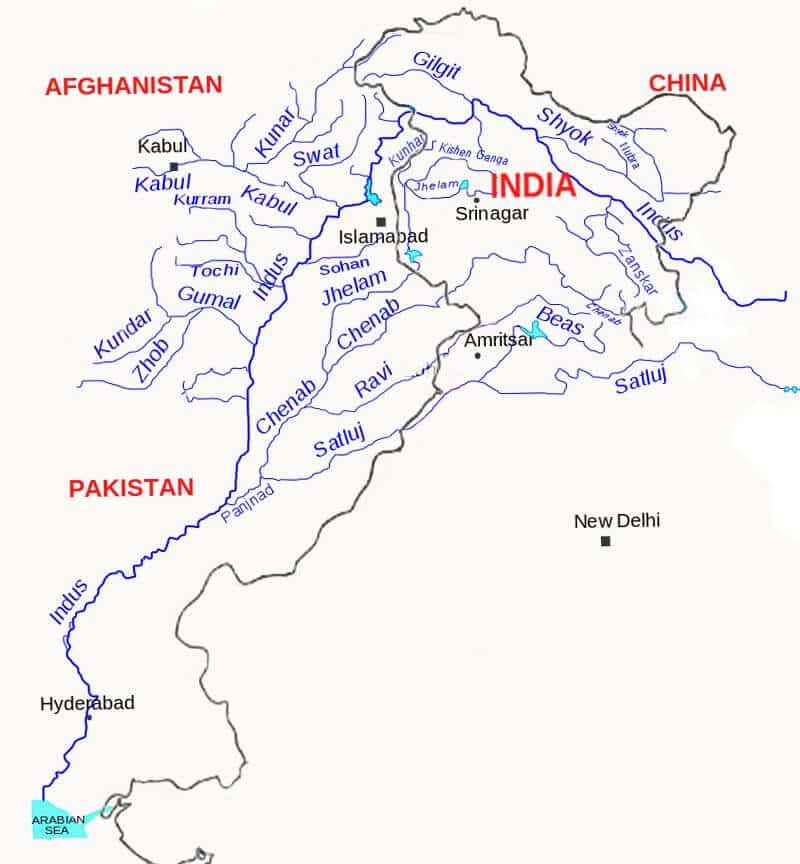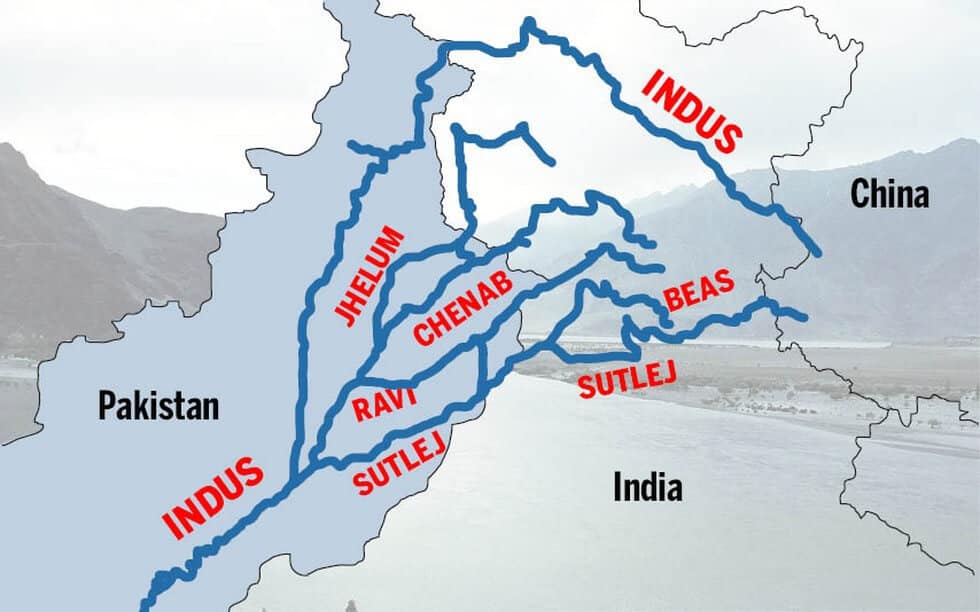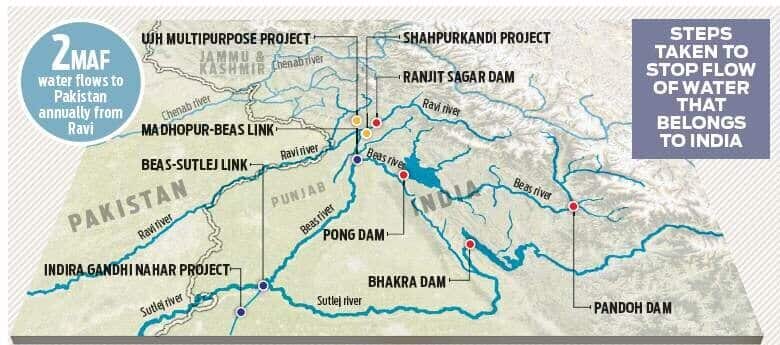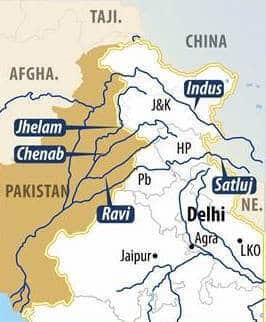The Indus river is one of the world’s largest river basins. It is also known as Sindhu. The river flows through China(Tibet region), India, and Pakistan. In Tibet, it is known as Singi Khambai or Lion’s mouth.
Himalayan River Systems
- The Indus, the Ganga, and the Brahmaputra comprise the Himalayan river systems.
- The Himalayan Rivers existed even before the formation of the Himalayas i.e. before the collision of the Indian Plate with the Eurasian plate. {Antecedent Drainage}
- They were flowing into the Tethys Sea. These rivers had their source in the now Tibetan region.
- The deep gorges of the Indus, the Satluj, the Brahmaputra, etc. clearly indicate that these rivers are older than the Himalayas.
- They continued to flow throughout the building phase of the Himalayas; their banks rising steeply while the beds went lower and lower due to vertical erosion (Vertical down cutting was significant and was occurring at a rate faster than the rising of Himalayas), thus cutting deep gorges.
- Thus, many of the Himalayan Rivers are typical examples of antecedent drainage.
Indus River System
- It originates from a glacier near Bokhar Chu in the Tibetan region at an altitude of 4,164 m in the Kailash Mountain range near the Mansarovar Lake.
- The river flows northwest and enters in Ladakh region in India from a place called Demchok, after entering India Indus river flows in between Karakoram and Ladakh range but more closer to the Ladakh range. At a place called Dungti, the river takes a sharp southwest turn and cuts through the Ladakh range and then takes a northwestern course and continues to flow towards the Leh region of Ladakh between Ladhak Range and Zaskar Range. After reaching Leh river countinues the northwestern course and reaches the town of Batalik which is in the Kargil district.
- It is joined by the Zaskar River at Leh.
- Near Skardu, it is joined by the Shyok at an elevation of about 2,700 m.
- The Gilgit, Gartang, Dras, Shiger, Hunza are the other Himalayan tributaries of the Indus.
- Now the Indus river enters into the Baltistan region through the city of sakardu and countinues to flow northwest towards the city of Gilgit, Upon reaching the city of Gilgit the river takes a south bend and then turns west and then fully enters the northwest frontier province of Pakistan which is called Khyber Pakhtunkhawa.
- The Kabul River empties into the Indus River near Attock, Pakistan. It is the main river in eastern Afghanistan and the Khyber Pakhtunkhwa province of Pakistan.
- The river then takes a southwestern course and countinues to flow across the Khyber Pakhtunkhwa province.
- It then flows through the plain in western and southern Punjab province of Pakistan, the river countinues to head towards the Sindhu province of Pakistan.
- Just above Mithankot, the Indus receives from Panjnad (Panchnad), the accumulated waters of the five eastern tributaries—the Jhelum, the Chenab, the Ravi, the Beas, and the Satluj.
- In Sindh Province river accumulates a lot of sediments and forms the Indus river delta before draining into the Arabian sea near Karachi.
- The blind Indus River Dolphin, a sub-species of dolphin, is found only in the Indus River.
Left and Right bank tributaries
- Zaskar river, Suru river, Soan river, Jhelum River, Chenab River, Ravi River, Beas river, Satluj river, Panjnad river are its major left-bank tributaries.
- Shyok River, Gilgit river, Hunza river, Swat river, Kunnar river, Kurram river, Gomal River, and Kabul river are its major right-bank tributaries.


Shyok River
- Rising from the Karakoram Range, it flows through the Northern Ladakh region in J&K
- It has a length of about 550km.
- A tributary of the Indus River, it originates from the Rimo Glacier.
- The river widens at the confluence with the Nubra River
- Shyok River marks the south-eastern fringe of the Karakoram ranges by forming a V-shaped bend around it.
Nubra River
- It is the main tributary of the Shyok River.
- It originated from the Nubra Glacier, in a depression to the east of Saltoro Kangri Peak
- Nubra River meanders towards the southeast to join the Shyok River downstream of Shyok Valley at the base of the Ladakh range
- Nubra Valley, situated at an altitude of 3048m, is formed out of the Nubra River
- The catchment area is devoid of vegetation and human habitation due to high elevation and lack of rainfall.
Shigar River
- It is a small right-bank tributary of the Indus River in its course through the Ladakh region of J&K
- It rises from the Hispar Glacier.
- It joins Indus at Skardu.
- The Shigar River descends down a very steep gradient
- Its entire catchment has been influenced by the action of glaciers.
Gilgit River
- It is an important right-bank tributary of the Indus River in its course through the Ladakh region of J&K
- It originates from a glacier near the extreme northwestern boundary of the Himalayas
- The entire catchment area of the Gilgit River is bleak and desolate
- Bunji is the main human settlement along the river
- Ghizar and Hunza are the major right and left bank tributaries respectively.
Hunza River
- It is an important left-bank tributary of the Gilgit River
- It rises from a glacier north of the Karakoram Range in the northwestern part of J&K
- It flows southeast and cuts across the Karakoram Range through a spectacular gorge
- Downstream, the Hunza River follows a southwesterly direction in its middle course
- Then it cuts across an offshoot of the Karakoram range and changes course to the southeast in its lower course before merging with the Gilgit a little upstream of Bunji where the latter river empties itself into the Indus.
Zanskar River
- It is one of the important left blank tributaries of the Indus
- Human settlements are sparse.
Chenab River
- The Chenab originates from near the Bara Lacha Pass in the Lahul-Spiti part of the Zaskar Range.
- Chenab river is formed by the confluence of the Chandra and Bhaga rivers at Tandi located in the upper Himalayas in the Lahul and Spiti District of Himachal Pradesh
- In its upper reaches, it is also known as the Chandrabhaga
- It flows through the Jammu region of J&K into the plains of Punjab in Pakistan
- The waters of the Chenab are allocated to Pakistan under the terms of the Indus Water Treaty
- Baghliar Dam has been constructed on this river
- The river is crossed in J&K by the world’s highest railways bridge name Chenab Bridge.
Jhelum River
- It is a tributary of the Chenab River and has a total length of 813km
- The river Jhelum rises from a spring at Verinag situated at the foot of the Pir Panjal in the southeastern part of the valley of Kashmir in India.
- The Kishenganga (Neelum) River, the largest tributary of Jhelum, joins it.
- The Chenab merges with the Sutlej to form the Panjnad River which joins the Indus River at Mithankot
- The waters of the Jhelum are allocated to Pakistan under the terms of the Indus WatersTreaty
- It ends in a confluence with the Chenab in Pakistan.

Kishanganga River
- It originates at Drass in the Kargil district of J&K
- The Neelam River enters Pakistan from India near the Line of Control and then runs west till it meets the Jhelum River
- It is also called as Neelam River (Neelum) either due to its sky cold water or due to the precious stone “ruby (Neelam)” that is found in this area
- It is famous for ice-cold water and trout fish.
Ravi River
- The Ravi River originates Dhauladhar range of the Himalayas in the Chamba district of HP. Ravi has its source in Kullu hills near the Rohtang Pass in Himachal Pradesh.
- It follows a northwesterly course and is a perennial river having a total length of about 720km
- The waters of the Ravi River are allocated to India under the Indus Waters Treaty
- The major multipurpose project built on the river is the Ranjit Sagar Dam ( Thein dam as it is located in Theinvillage)
- Chamba town is situated on the right bank of the river.
- The right bank tributaries of the Ravi are the Budhil, Tundahan Beljedi, Saho and Siul; and its left bank tributary worth mentioning is Chirchind Nala.
- The Ujh river is a tributary of the Ravi River that flows through the Kathua district in the Indian union territory of Jammu and Kashmir.
- Ujh Multipurpose Project is planned to be constructed in Kathua District of Jammu & Kashmir on the River Ujh.
- Shahpurkandi Dam project is located on the Ravi River in Pathankot district, Punjab, downstream from the existing Ranjit Sagar Dam.

Sutlej River
- The Sutlej is sometimes known as the Red River.
- It rises from beyond the Indian borders in the southern slopes of the Kailash Mountain near Mansarover Lake from Rakas Lake.
- It enters HP at Shipki La and flows in the South-westerly direction through Kinnaur, Shimla, Kullu, Solan, Mandi, and Bilaspur districts.
- It leaves HP to enter the plains of Punjab at Bhakra, where the world’s highest gravity dam- Bhakra Nangal Dam, has been constructed on this river.
- The waters of the Sutlej are allocated to India under the Indus Water Treaty b/w India and Pakistan and is mainly used for power generation and irrigation of many large canals draw water from it
- Across the river, there are many hydroelectric and irrigation projects such as the Kol Dam, Nathpa Jhakri project.
Beas River
- Beas River, an important river of the Indus River System, emerges from Rohtang pass in HP
- The river before entering Pakistan merges with the Sutlej River at Hari-Ke-Pattan in Punjab
- The total length of this river is 460km and the river covers 256km through HP
- The tourist resorts of Manali is situated on the right banks of the River Beas.
Indus Waters Treaty 1960
- The Indus system comprises of main Indus River, Jhelum, Chenab, Ravi, Beas, and Sutlej. The basin is mainly shared by India and Pakistan with a small share for China and Afghanistan.
- Under the treaty signed between India and Pakistan in 1960, all the waters of three rivers, namely Ravi, Sutlej, and Beas ( Eastern Rivers) were allocated to India for exclusive use.
- While, the waters of Western rivers – Indus, Jhelum, and Chenab were allocated to Pakistan except for specified domestic, non-consumptive, and agricultural use permitted to India as provided in the Treaty.
- India has also been given the right to generate hydroelectricity through the run of the river(RoR) projects on the Western Rivers which, subject to specific criteria for design and operation is unrestricted.
Present Developments
- To utilize the waters of the Eastern rivers which have been allocated to India for exclusive use, India has constructed the following dams:
- Bhakra Dam on Satluj,
- Pong and Pandoh Dam on Beas and
- Thein (Ranjit Sagar) on Ravi.
- Other works like Beas-Sutlej Link, Madhopur-Beas Link, Indira Gandhi Nahar Project, etc has helped India utilize nearly the entire share (95 %) of the waters of Eastern rivers.
- However, about 2 Million Acre Feet (MAF) of water annually from Ravi is reported to be still flowing unutilized to Pakistan below Madhopur.
- To stop the flow of these waters that belong to India for its utilization in India, the following steps have been taken:
- Shahpurkandi Project: This project will help in utilizing the waters coming out from the powerhouse of Thein dam for irrigation and power generation in J&K and Punjab. The construction work is being undertaken by the Govt of Punjab under the monitoring of the Govt of India.
- Construction of Ujh multipurpose project: This project will create storage of water on river Ujh, a tributary of Ravi for irrigation and power generation in India. This project is a National Project whose completion period will be 6 years from the beginning of the implementation.
- The 2nd Ravi Beas link below Ujh: This project is being planned to tap excess water flowing down to Pakistan through river Ravi, even after construction of Thein Dam, by constructing a barrage across river Ravi for diverting water through a tunnel link to Beas basin. Govt. of India declared this project as National Project.
- The above three projects will help India to utilize its entire share of waters given under the Indus Waters Treaty 1960.


I am first time reading this tutorial and found some mistake (confusion) at very fast, according to this post it says the Indus follows between Karakoram and Ladakh but in the book of Majid Hussain it is in between Ladakh and Janskar even the Oxford Atlas clearly shows it between Ladakh and Janskar.
Please correct me if I am wrong.
Whatever the above mentioned Karakoram and Ladakh range is correct and also zanskar river is in ladakh.
After the place called Dungti, Indus River flows between Ladhak Range and Zaskar Range.
Great video, good explanation.
Jhelum ravi vyas sutluj and chenab are left tributaries of river indus…..plz correct
In 11th ncert it is mentioned that Indus flows between ladakh and zaskar range . Which one it right ?
After the place called Dungti, Indus River flows between Ladhak Range and Zaskar Range.
what actually eastern and western division of 5 punjab rivers mean. On what basis it is done can you please explain.
Amazing
Rectify this, Jhelum is not a tributary of Chenab as highlighted
Sorry but it certainly is
One of the best contant I can say. In a systematic and detailed way.